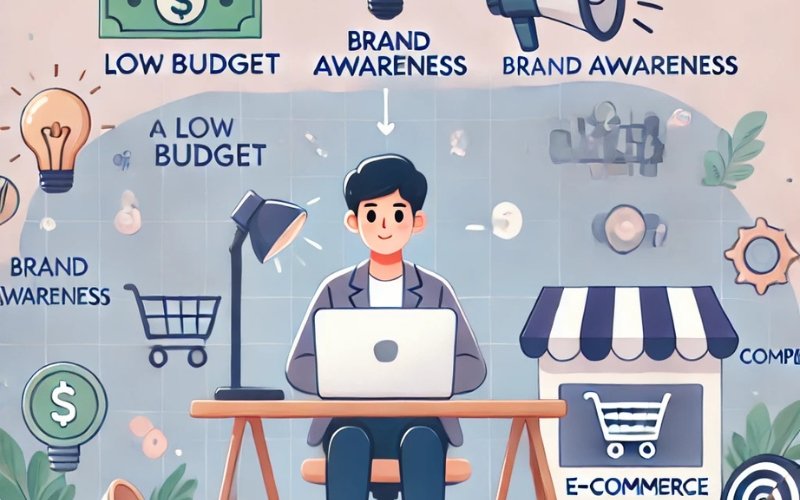Starting and growing a small e-commerce business can be a rewarding endeavor, but it comes with its own set of challenges. In an increasingly competitive digital landscape, small businesses must navigate limited resources, minimal brand awareness, and the complexities of scaling effectively. Understanding these challenges is key to developing strategies that will ensure long-term success. This article will explore some of the primary obstacles that small e-commerce businesses face.
Limited Budget and Resources

One of the most significant hurdles for small e-commerce business owners is operating with a limited budget. Unlike larger companies with vast resources to invest in advanced technologies, extensive marketing campaigns, and customer acquisition strategies, small businesses often have to make do with fewer financial resources. This limitation poses challenges when trying to compete in a crowded and highly competitive market.
Challenges of Operating on a Limited Budget
A tight budget can restrict a small e-commerce business from investing in areas that are crucial for growth. For instance:
- Paid Advertising: While platforms like Google Ads and social media advertising offer targeted campaigns, the costs can quickly escalate, making it difficult for small businesses to sustain long-term advertising efforts.
- Professional SEO Services: Effective search engine optimization is essential for driving organic traffic, but hiring professional SEO agencies or consultants may be beyond the financial reach of many small businesses.
- High-Quality Web Development: A professional, well-optimized website is the foundation of any successful e-commerce business, but custom development and design can be costly. Limited budgets often force small businesses to rely on DIY solutions or less-than-ideal website templates.
Cost-Effective Strategies for Small E-commerce Businesses
Due to these financial constraints, small e-commerce businesses must focus on cost-effective strategies to maximize their resources and drive growth. Some of the most impactful approaches include:
- Organic Search Engine Optimization (SEO):
Organic SEO allows small businesses to improve their search engine rankings without the need for paid advertising. By optimizing product descriptions, utilizing relevant keywords, and creating high-quality blog content, small e-commerce businesses can attract more traffic to their websites over time. While this approach requires consistent effort and a solid understanding of SEO principles, it is a budget-friendly way to build visibility. - Content Marketing:
Creating valuable and informative content is an excellent way to engage potential customers while positioning your brand as an authority in the industry. Blog posts, product guides, and how-to videos can drive organic traffic and improve customer trust, ultimately benefiting the e-commerce business without requiring substantial financial investment. - Social Media Marketing:
Social media platforms offer cost-effective ways to promote products and connect with audiences. Small e-commerce businesses can leverage free tools, organic posts, and affordable ads on platforms like Instagram, Facebook, and Pinterest to build brand awareness and drive traffic. - Email Marketing:
Building and nurturing an email list is another low-cost but highly effective strategy. Personalized email campaigns allow small businesses to engage directly with their customers, promoting special offers, new arrivals, and updates.
The Importance of Time and Effort
Even with these cost-effective strategies, small e-commerce businesses face challenges in execution. Success often requires a significant investment of time, consistent effort, and a willingness to learn. Many business owners wear multiple hats, juggling tasks like marketing, inventory management, and customer support. These demands make it essential to prioritize activities that deliver the highest return on investment.
Low Brand Awareness

Low brand awareness is a significant hurdle that small e-commerce businesses often face, especially when first entering a competitive market. New businesses struggle to capture attention in a space dominated by established brands with larger budgets, robust marketing strategies, and long-standing customer loyalty. Building recognition and trust takes time and effort, making it difficult for new players to stand out and thrive.
Why Low Brand Awareness is a Challenge
Consumers are naturally inclined to trust brands they recognize. Established companies have already built credibility through consistent marketing, quality products, and positive customer experiences. This puts small businesses at a disadvantage, as they must work harder to convince potential customers of their value.
In the e-commerce landscape, visibility is crucial. Small businesses often face the challenge of competing with larger companies that dominate search engine rankings and social media platforms. These competitors benefit from higher budgets for paid advertising, more extensive networks, and established reputations. Without a recognizable brand, even the most well-designed websites and high-quality products may remain unnoticed by potential customers.
Additionally, low brand awareness often results in low website traffic and poor conversion rates. Customers who are unfamiliar with your brand are less likely to trust your products or services, leading to abandoned carts or a reluctance to engage with your website.
Strategies to Overcome Low Brand Awareness
While the challenge of low brand awareness can be daunting, small e-commerce businesses can take strategic steps to build recognition and gain a competitive edge.
- Invest in Content Marketing:
Producing valuable and informative content can help position your brand as an authority in your niche. Blog posts, videos, and infographics not only attract organic traffic but also educate potential customers about your products and values, fostering trust. - Leverage Social Media:
Social media platforms are powerful tools for building brand awareness. Regularly posting engaging content, running targeted ads, and collaborating with influencers can help you reach a broader audience and establish your brand’s presence. - Focus on SEO:
Optimizing your website for search engines ensures that your brand appears in front of potential customers actively searching for products or services you offer. Targeting long-tail keywords and improving on-page SEO can help small businesses rank higher, driving more visibility. - Offer Exceptional Customer Service:
Outstanding customer service creates positive experiences, encouraging word-of-mouth referrals and repeat purchases. Satisfied customers often share their experiences with friends and family, boosting your brand’s reputation. - Utilize Email Marketing:
Building an email list allows you to stay connected with your audience. Personalized email campaigns can nurture relationships and keep your brand top-of-mind, even when customers aren’t actively shopping.
Building a Memorable Brand
Building brand awareness takes consistent effort and creativity. Developing a strong brand identity, including a compelling logo, memorable tagline, and cohesive visual elements, can make your business more recognizable. Coupled with a focus on storytelling and authentic engagement, small businesses can carve out a niche in the market.
Building Trust and Credibility

Alongside low brand awareness, building trust with potential customers can be a struggle for small e-commerce businesses. Online shoppers tend to be cautious, especially when purchasing from unfamiliar websites. Trust issues can stem from concerns about payment security, product quality, or customer service.
Establishing credibility involves using secure payment systems, providing clear return and shipping policies, and displaying customer reviews. Additionally, small businesses can benefit from professional-looking websites, active social media engagement, and transparent communication with customers. While these steps are important, gaining customer trust takes time and consistent effort, which can be frustrating for new businesses looking for immediate results.
Driving Traffic to the Website
For small e-commerce businesses, getting traffic to their website is one of the hardest challenges, especially in the early stages. With limited funds for paid ads and digital marketing, organic traffic from search engines becomes vital. However, achieving high rankings on search engines like Google can take months, even with a solid SEO strategy.
In the meantime, small businesses must rely on other methods to drive traffic, such as social media marketing, email campaigns, and partnerships with influencers. These efforts can help generate initial traffic, but sustained growth requires continuous optimization and adaptation.
Fierce Competition
The e-commerce sector is highly competitive, with thousands of businesses vying for the same customers. Larger companies often have the upper hand due to their established customer bases, superior resources, and economies of scale, which allow them to offer lower prices and fast shipping options.
Small e-commerce businesses must find ways to differentiate themselves. This could be through niche products, personalized customer service, or unique brand storytelling. However, even with these efforts, competing against well-established brands remains a significant challenge.
Conclusion
The challenges facing small e-commerce businesses are numerous, but with careful planning and strategic thinking, these obstacles can be overcome. Limited budgets, low brand awareness, and tough competition require small businesses to be resourceful, focusing on affordable and sustainable growth strategies. By understanding these challenges, e-commerce business owners can develop more effective solutions to build trust, increase visibility, and ultimately achieve long-term success.

